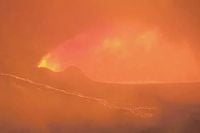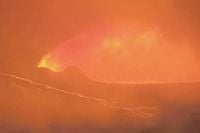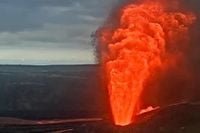On August 22, 2025, Hawaii’s Kilauea volcano once again commanded the world’s attention, erupting for the 31st time since December 2024. This latest display of nature’s power offered a breathtaking spectacle: lava fountains soared 100 feet into the air, illuminating the night sky and drawing crowds to Hawaii Volcanoes National Park. The eruption, contained entirely within the summit crater, posed no threat to surrounding homes, but it did provide a front-row seat to one of the planet’s most dynamic geological phenomena.
As reported by Phys.org and echoed across local and international media, the north vent at Kilauea’s summit began spattering lava continuously in the early hours. By afternoon, the activity intensified, sending arcs of molten rock skyward and across the crater floor. For those unable to witness the event in person, livestreams provided by the U.S. Geological Survey (USGS) offered a digital window into the unfolding drama. Hundreds of thousands tuned in to catch the action from three different camera angles, underscoring the global fascination with Kilauea’s fiery temperament.
Janice Wei, a volunteer at the park and an avid documentarian of the volcano’s moods, described the scene with palpable excitement. “Every eruption feels like I am sitting in the front row at nature’s most extraordinary show,” she shared, capturing images and videos not just for herself, but for educational outreach as well. When the lava jets skyward, Wei said, it sounds like a roaring jet engine or crashing ocean waves—a symphony of power that can be felt even from a mile away.
Kilauea’s latest eruption is not an isolated event, but part of a relentless series that has kept the Hawaiian Volcano Observatory (HVO) on its toes since late 2024. The volcano, located about 200 kilometers (or 320 miles) south of Honolulu on Hawaii Island, is renowned as one of the most active in the world. Its frequent eruptions have made it a living laboratory for scientists and a magnet for tourists and locals alike. In April 2025, park visitation soared by 49% compared to the same month the previous year—a testament to the draw of witnessing Earth’s raw creative force in action.
But what fuels these spectacular fountains of lava? Ken Hon, scientist-in-charge at the HVO, offered insight into the subterranean mechanics. The lower magma chamber beneath Halemaumau Crater is constantly fed by magma from deep within the Earth at a rate of about 5 cubic yards (3.8 cubic meters) per second. This relentless influx inflates the chamber like a balloon, building pressure that eventually forces magma upward into an upper chamber. From there, the molten rock bursts through cracks and vents, sometimes erupting in dramatic fountains that can, in some cases, exceed 1,000 feet (300 meters) in height.
Hon likened the challenge of studying Kilauea to “being a bunch of ants crawling on an elephant trying to figure out how the elephant works.” The volcano’s behavior, while somewhat predictable in its frequency, is still full of surprises. Each eruption is unique, shaped by subtle changes in pressure, gas content, and vent structure. Notably, the recent eruptions have produced shorter but wider fountains—a shift that Steve Lundblad, a geology professor at the University of Hawaii at Hilo, attributes to a widening vent. “We’re still gonna have spectacular eruptions,” Lundblad remarked. “They’re just going to be wider and not as high.”
This pattern of repeated lava fountains is rare even for Kilauea. According to historical records, this is only the fourth time in two centuries that the volcano has produced such a sequence. The last major episode began in 1983, resulting in 44 sessions of lava fountains over three years before transitioning to a continuous lava flow that persisted until 2018. Previous similar patterns occurred in 1959 and 1969. Whether the current eruption will evolve into another long-lasting event remains an open question. Scientists monitor the volcano closely, using seismic sensors and ground movement detectors to estimate when magma is likely to reach the surface, sometimes days or even a week in advance.
Beyond the science, Kilauea’s eruptions carry profound cultural and spiritual meaning for the Hawaiian community. The volcano is revered as the home of Pele, the goddess of fire, and its activity is woven into the fabric of local traditions and stories. Huihui Kanahele-Mossman, executive director of the Edith Kanakaʻole Foundation, emphasized the importance of these cultural connections. For her, witnessing an eruption is more than a spectacle; it is a living link to the mele—Hawaiian songs and chants that recount the island’s creation and the exploits of Pele.
“You as the dancer, you are the storyteller and you carry that history that was written in those mele forward,” Kanahele-Mossman explained. She visits the crater to offer chants and traditional gifts, such as awa (a drink made from kava) and fern leis, honoring both the natural event and the ancestral narratives that define Hawaiian identity. For many, the lava represents more than destruction—it is the genesis of new land, the foundation upon which Hawaii itself is built.
The eruption’s draw is not without its hazards. Park spokesperson Jessica Ferracane urged visitors to remain vigilant. Some recent lava fountains have lasted only 10 to 12 hours, making timing unpredictable. Volcanic gases, ash, and glass can pose serious health risks, while unstable cliffs and hidden cracks in the earth present physical dangers, especially at night. Ferracane advised that visitors “stay on marked trails and overlooks,” keep children close, and bring flashlights for nighttime excursions. The USGS continues to provide real-time alerts to help keep the public informed and safe.
Despite the risks, the allure of Kilauea’s eruptions remains irresistible. For scientists, each event offers a new puzzle to solve. For locals and visitors, it is a chance to witness the birth of land and the power of nature up close. And for the Hawaiian community, it is a moment to honor traditions that stretch back centuries, blending reverence with awe in the shadow of Pele’s fiery home.
As Kilauea’s fountains continue to dazzle and mystify, the world watches—reminded that even in an age of scientific advancement, some of Earth’s oldest forces remain as unpredictable and enchanting as ever.



